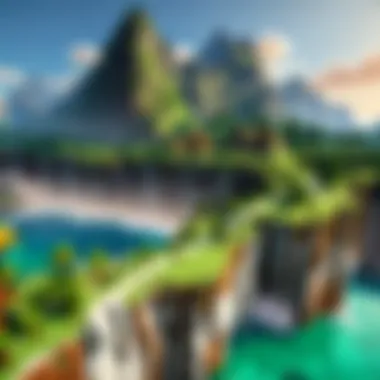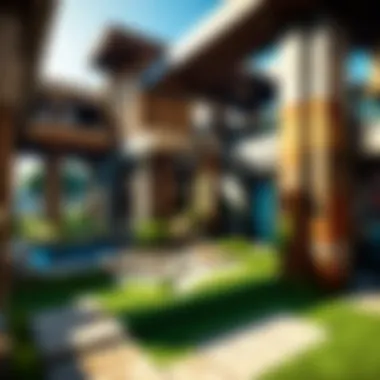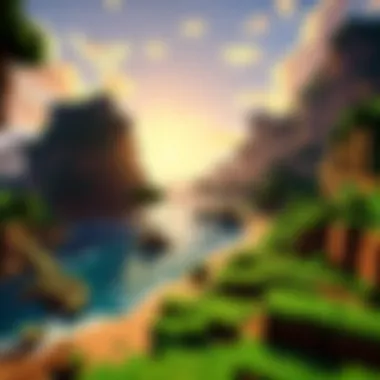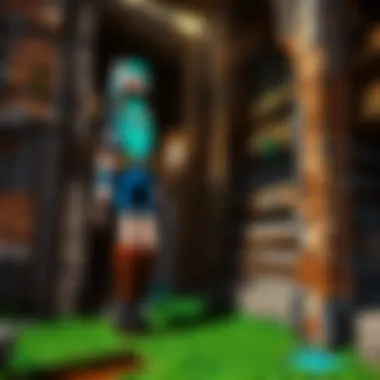Exploring the Free Play of Minecraft: A Comprehensive Overview


Intro
Exploring free play in Minecraft opens the door to understanding the vast possibilities it offers to players. Free play, in its essence, allows individuals to engage with the game without constraints, fostering creativity and personal expression.
The dynamic nature of this mode encourages players to build, explore, and interact in ways that resonate with their personal style. It's not merely about survival or completing objectives; it’s about the journey of creativity and discovery.
As players embark on their adventures, they navigate a world that is both familiar and ever-evolving. The lack of predetermined goals fosters a sense of freedom, allowing players to immerse themselves fully in the experience. This exploration is crucial for all ages. It creates a foundation for learning through play, instilling vital problem-solving skills and social interaction.
This article will present a comprehensive view of free play in Minecraft, analyzing its mechanics and significance while providing insights into its impact on player experience.
Understanding the Concept of Free Play
Free play is a fundamental aspect of gaming, especially in sandbox environments like Minecraft. It allows players to explore, create, and interact within a virtual space without the constraints of predefined objectives or rules. This section will examine the nuances of free play, emphasizing its importance and benefits in the gaming landscape.
Defining Free Play in Gaming
Free play, in gaming terms, refers to modes or environments where players can engage with the game world without strict limitations or requirements. In this context, it is characterized by autonomy and creative opportunity. Players can make choices that shape their gaming experience, guiding their actions based on personal preferences and curiosity rather than imposed challenges. This freedom is what distinguishes free play from more structured gameplay found in other genres, where players might follow a specific narrative or set of rules.
The essence of free play allows for experimentation and self-directed learning. As players interact with the world, they develop skills in problem-solving and critical thinking. They can build structures, gather resources, and innovate designs based solely on their creativity. This flexibility encourages a unique learning process that can engage players of all ages. Indeed, free play is not just a recreational escape; it is also a powerful tool for cognitive development.
Historical Context of Free Play
Understanding the historical context of free play in gaming provides insight into its evolution and significance. The concept of open-ended gameplay is not new; it can be traced back to early video games that offered players a degree of freedom. However, it became more pronounced with the advent of sandbox games like Minecraft.
Minecraft, launched in 2011, revolutionized the gaming landscape. It introduced a block-based world where players could mine, build, and explore at their own pace. This shift from linear storytelling to open-ended gameplay marked a pivotal moment in game design. Developers recognized the importance of player agency, leading to a surge in similar titles that emphasize free play.
The rise of online communities also influenced free play. Players began sharing their creations and experiences, creating a culture around not just playing, but showcasing and discussing their gameplay. This collaborative aspect enriched the gaming experience, allowing players to learn from one another and inspire each other creatively. As a result, free play has transformed into a collective journey, marked by individual creativity within a shared environment.
"Free play is where the real magic of creativity happens, allowing players to turn their visions into reality."
Free Play Mode in Minecraft
In the realm of Minecraft, the concept of Free Play Mode stands out as a defining characteristic that greatly enhances the gaming experience. This mode eschews stringent goals and missions, allowing players to explore and create without restrictions. Free Play is essential for fostering creativity, encouraging exploration, and allowing individual expression. It presents unique opportunities for players to engage with the game in personal and innovative ways.
Overview of Minecraft's Free Play
Minecraft's Free Play Mode is often regarded as the game’s purest form. It permits players to enter a world devoid of predefined objectives or time constraints. Instead, they can interact with the environment at their own pace. The absence of a structured gameplay loop introduces a distinctive freedom, enabling players to develop their own gameplay narratives. Here, players can choose to explore the vast landscapes, gather resources, or construct intricate buildings without any imposed limits. This mode is particularly appealing to a diverse audience, from casual players to those seeking a more immersive creative outlet.
Key Features of Free Play
Several key features distinguish Free Play Mode within Minecraft:
- Unlimited Resources: Players can access limitless material to build and craft, promoting creativity without the constraints of resource scarcity.
- World Customization: The ability to shape the world allows for the creation of unique landscapes and structures. Minecraft's block-based design encourages architectural exploration.
- Exploration Freedom: Players can traverse various biomes, discovering new areas and the diverse flora and fauna they offer.
- No Time Limits: The absence of pressure adds a relaxed atmosphere to the game, letting players focus on their projects without the worry of failing or rushing.
By engaging with these features, players of all ages can immerse themselves in a project of their choice, enabling learning and creativity to flourish in a nurturing environment. To understand the full impact of Free Play, it’s crucial to recognize how these elements combine, giving players the tools to craft their own adventures and experiences.
The Mechanics of Free Play
The mechanics of free play in Minecraft form the backbone of the player's experience. These mechanics dictate how players can interact with the game world, influencing both creativity and exploration. Understanding these mechanics allows players to utilize the full potential of the game. Each aspect of the mechanics plays a role in providing a sandbox environment where players can thrive, explore, and express themselves.
World Generation and Exploration


World generation in Minecraft is procedurally generated, creating vast and diverse environments. Each new world is a unique landscape that can include mountains, forests, deserts, and oceans. The randomness of this generation is key because it means players will encounter new challenges and experiences every time they start a new game.
Exploration is also important because it contributes to the sense of adventure. Players venture into unknown territories, uncovering secrets and resources which enrich their gameplay. The exploration mechanisms promote curiosity, urging players to dig deeper into their worlds. Finding rare biomes or structures can be particularly rewarding.
Key Points on World Generation:
- Randomized Biomes: Highlights variations in gameplay.
- Discovery Incentives: Encourages players to explore.
- Unique Features: Each world can surprise with new elements.
Building and Crafting Freedom
In Minecraft, the construction and crafting systems offer unparalleled freedom. Players can design complex structures or simple homes using a variety of blocks. This flexibility is essential for self-expression. A single block can be part of a grand castle or a minimalistic design. Players can create their designs, resulting in personal satisfaction.
Crafting allows players to combine resources to create tools, weapons, and other useful items. This system can vary based on the materials available, meaning every player’s experience can differ significantly based on their choices. The crafting table is a vital tool providing numerous recipes, allowing players to explore their creativity.
Benefits of Building and Crafting:
- Infinite Possibilities: Built from player imagination.
- Resource Management: Requires strategic thinking.
- Community Sharing: Players can showcase their works.
Game Physics and Interaction
Game physics in Minecraft includes the simulation of gravity, fluid dynamics, and entity interactions. This adds a layer of realism that affects how players approach building. For example, structures must be designed to withstand gravity, and water must flow correctly. Such considerations introduce a tactile element to creativity.
Interactivity with the game world extends beyond just building. Players can move, destroy or manipulate objects, affecting the environment. This dynamic provides opportunities for ingenuity in both gameplay and construction.
Important Note: Game physics influence player strategies, adding depth to construction and problem-solving.
Components of Game Physics:
- Gravity Effects: Essential when building tall structures.
- Liquid Dynamics: Requires planning for water and lava use.
- Interaction with The Environment: Promotes engagement.
Player Creativity and Expression
The concept of player creativity and expression in Minecraft is immensely significant. It enables players to harness their imaginative faculties in a medium that provides limitless possibilities. Unlike many traditional games, Minecraft allows for a degree of expression that goes beyond mere mechanics or objectives. Players are not merely participants; they are architects in a digital landscape, crafting intricate worlds that reflect their personal style and preferences. This creates an engaging experience that encourages innovation and individuality.
In free play mode, Minecraft offers tools and resources that facilitate not only building but also storytelling. Players can create narratives through their constructions, whether they choose to replicate real-world landmarks or invent fantasy realms. This unique capability fosters a sense of ownership, as players invest time and effort into their creations, making the game deeply personal.
The benefits of embracing creativity and expression in Minecraft are numerous. First, it nurtures artistic skills, allowing players to explore aesthetics and design principles. Second, it encourages experimentation, leading to unique solutions and approaches to gameplay. Additionally, it can build confidence; as players showcase their work, they often receive feedback from peers. Such interactions can reinforce a sense of community and belonging, which is vital for social engagement.
Designing Unique Worlds
Designing unique worlds within Minecraft is a testament to the platform's potential for creativity. Each world represents not only the player’s skills but also their vision and inspirations. From sprawling cities to serene nature parks, the environments players create can evoke a range of emotions and reactions.
Players start by selecting a biome, which influences the world’s characteristics, such as climate and resources. This initial choice sets the stage for the creative process. As they mine resources and explore, players become storytellers by embedding personal narratives within their designs. For instance, building a hidden village on a mountain adds a layer of intrigue.
Some players engage in specific themes when designing their worlds. These themes can stem from architectural styles, such as medieval or futuristic, or they may be inspired by popular culture references. This thematic creativity invites further exploration and encourages collaboration with others who share similar interests. An example of this might be a player recreating a famous movie scene using blocks in Minecraft, thus merging two forms of art and expression.
Personal Projects in Free Play
Personal projects in Minecraft often stand as a hallmark of individual creativity. These projects can range from small builds, like personal homes, to expansive endeavors such as entire cities or even replicas of well-known monuments.
One essential aspect of personal projects is the project management skills players inherently develop. They plan, create timelines, and allocate resources. With the building process often requiring careful thought and coordination, players must assess and rethink their designs frequently to achieve the desired outcome. This leverage of logic and critical thinking contributes to their overall cognitive development.


Moreover, personal projects in Minecraft can significantly impact players outside the game. The skills cultivated in Minecraft, ranging from design thinking to resource management, can translate into real-world applications. Players often share their personal projects online through platforms like Reddit or Facebook, gaining recognition and feedback that further enhances their skills and creativity. This sense of community encourages continuous improvement and fosters connections that can extend beyond the virtual environment.
"Minecraft provides an open canvas where players can express their creativity without boundaries, transforming the gaming experience into a unique artistic journey."
In essence, Player Creativity and Expression in Minecraft is not just a feature; it is an integral part of what makes the game appealing to many. By designing unique worlds and undertaking personal projects, players explore their creativity in ways that resonate on multiple levels.
Collaboration and Social Interaction
Collaboration and social interaction in Minecraft can be seen not just as a feature but as a fundamental aspect of the game. Players engage with others, forming bonds through shared experiences and collaborative builds. This interaction enhances the gaming experience in distinct ways, creating a vibrant community and a sense of belonging.
Community Building and Multiplayer Options
Community building is integral to the Minecraft experience. Players can join servers, where they collaborate on projects or engage in mini-games. Whether building castles or digging vast mines, teamwork often leads to larger, more ambitious creations. Multiplayer options enhance this aspect by enabling real-time interaction. Players can easily communicate through in-game chat or voice channels. This fosters relationships that transcend the game, resulting in friendships formed among those who might never meet in person.
Some key benefits of community building in Minecraft include:
- Shared Knowledge: Players often share tips and strategies, helping others improve skills.
- Enhanced Creativity: Collaborating with others can spark new ideas and approaches to building.
- Social Development: Working in teams teaches important social skills, like communication and compromise.
Sharing Creations Online
The ability to share creations online adds another layer to the Minecraft experience. Players frequently use platforms like Reddit and Facebook to showcase their builds and seek feedback from the community. This sharing not only validates individual efforts but also inspires others. When players see unique designs and innovative concepts, it encourages them to experiment and push their own creative boundaries.
Online sharing serves various purposes:
- Feedback: Receiving constructive criticism can help improve skills and concepts.
- Recognition: Highlighting accomplishments allows players to gain validation and recognition.
- Inspiration: Discovering what others have built sparks curiosity and can lead to new projects of one’s own.
"Sharing your work can be as rewarding as building it. It creates a cycle of inspiration."
These interactions create a rich ecosystem where everyone learns and grows together, reinforcing the concept that Minecraft is not just a solitary journey but a shared adventure.
Engagement in multiplayer modes, along with the sharing culture, transforms individual gameplay into something collectively significant. As players build together and share creations, they contribute to a community that thrives on collaboration and social interaction. This sense of community is what keeps players returning to the game, making their experiences not merely about building blocks but about building relationships.
Learning Through Free Play
Free play in Minecraft offers a unique opportunity for players to engage with the game in a manner that promotes learning. This section will examine how free play cultivates essential cognitive skills and presents effective problem-solving strategies. Understanding these elements aids in appreciating the deeper impact of Minecraft’s free play environment on players of varying ages and skill levels.
Cognitive Skills Development
Engaging with Minecraft in its free play mode significantly enhances cognitive skills. Players are encouraged to employ critical thinking and spatial reasoning while navigating and constructing within the game world. The sandbox nature of Minecraft allows for a wide range of interactions, leading to an increase in strategic planning. For example, when building complex structures, players must assess the available resources and how best to utilize them. This exercise in planning strengthens spatial awareness, which is a cognitive skill beneficial in real-world applications.
Additionally, free play challenges players to adapt to the dynamic environment of Minecraft. Each world is procedurally generated, presenting unique landscapes and scenarios. This variability compels players to approach tasks with creativity and flexibility. Experimentation becomes a key part of this learning process, as players discover new techniques and strategies by trial and error. Such experiences foster a growth mindset, reinforcing the idea that skills can be developed through persistent effort.
Problem-Solving Strategies
Free play mode emphasizes problem-solving in diverse scenarios. Players encounter obstacles that require innovative approaches to overcome. For instance, a player might face the challenge of traversing a difficult terrain or protecting their creations from hostile mobs. Each challenge provides a learning opportunity, requiring players to evaluate their resources and develop strategies effectively.
The use of collaborative problem-solving is also significant in multiplayer settings. Players can combine their knowledge and skills to tackle larger projects or challenges. This collaboration not only strengthens social skills but also enhances problem-solving abilities as players engage in discussions, share insights, and arrive at collective decisions.
"The freedom to build and explore leads to significant cognitive advancements that transcend the game itself."
Limitations and Challenges of Free Play


Free play in Minecraft is a double-edged sword. While it fosters creativity and exploration, it also presents limitations and challenges that players must navigate. Understanding these drawbacks is crucial for maximizing enjoyment and engagement in the game. This section delves into two primary challenges: resource management and the potential for creative block.
Resource Management Issues
In Minecraft, resource management is a fundamental aspect that affects gameplay. Players collect materials to build, craft, and survive. In free play, the abundance of resources can lead to certain issues. As players gather materials extensively, they may find themselves overwhelmed or uncertain about how to utilize their resources effectively.
- Players might hoard items, leading to clutter in their inventory. This could result in frustration, as finding needed items becomes cumbersome.
- Limited storage space often compels players to make hard choices about what to keep and what to discard. This process requires strategic thinking, which some players may find challenging.
- The game's survival mode further complicates resource management, as players need to balance gathering with defending against mobs.
Learning to manage resources efficiently is critical for enhancing the free play experience. Understanding how to prioritize what to gather can lead to greater satisfaction and more opportunities for creativity.
Potential for Creative Block
Even in a sandbox environment like Minecraft, where the possibilities seem endless, players can experience a creative block. This phenomenon hinders the ability to generate new ideas or projects. Factors contributing to this challenge include:
- Repetition: Engaging in similar building projects can become monotonous. Players might feel stuck in a loop, struggling to come up with fresh concepts.
- Expectations: High self-imposed standards can stifle creativity. Players may worry that their creations won’t meet community standards or personal aspirations, resulting in anxiety.
- Lack of Inspiration: Without a clear goal or guidance, some players may find it difficult to muster the motivation to create. This can lead to frustration and decreased enjoyment of the game.
It's essential to recognize that creative blocks are a natural part of the creative process. Finding methods to overcome them could include seeking inspiration from other players, participating in community challenges, or simply taking breaks to return with a fresh perspective.
"The beauty of sandbox games lies in the freedom they provide, but with freedom comes the responsibility to navigate challenges effectively."
By acknowledging and addressing these limitations, players can enhance their overall Minecraft experience. Understanding resource management and combating creative blocks are vital skills that can elevate the quality of gameplay and make the journey in free play both rewarding and fulfilling.
The Future of Free Play in Minecraft
The future of free play in Minecraft has substantial implications for both players and developers. As the gaming landscape evolves, understanding these trends is crucial for maintaining engagement and satisfaction among users. This section will examine upcoming features and updates in Minecraft's free play mode, along with broader trends in gaming and sandbox environments.
Upcoming Features and Updates
The developers of Minecraft are consistently innovating, introducing new features that enhance the free play experience. Recent updates have brought various technical improvements and new content. Noteworthy changes include:
- Biomes and Dimensions: The introduction of new biomes increases exploration opportunities. Players now can discover lush caves and varied landscapes that significantly enhance the free play experience.
- New Blocks and Items: The addition of blocks like copper and amethyst encourages innovative building and creativity. Crafting unique items fosters an environment where imagination can thrive.
- Gameplay Mechanics: Enhancements in AI and game physics allow players to engage with their environments in more meaningful ways. Interactions with mobs and the world itself are becoming richer.
What can players anticipate in the near future? More frequent updates that incorporate player feedback are likely. This responsiveness can lead to a more tailored gaming experience, aligning with player preferences.
Trends in Gaming and Sandbox Environments
Minecraft not only adapts to its community but also reflects larger trends within the gaming industry. Sandbox games have gained popularity due to their open-ended nature. Observing current trends helps us understand Minecraft's trajectory. Key trends include:
- Focus on User-Generated Content: Players increasingly desire to share their creations. Enhancements to sharing platforms could amplify community interaction.
- Integration of Technology: Virtual reality and augmented reality are becoming more common. Minecraft might explore these avenues to offer immersive experiences.
- Educational Value: Games that promote learning through play continue to receive attention. Minecraft's free play fosters creativity but also teaches problem-solving skills. This could lead to collaborations with educational institutions.
Minecraft stands at the intersection of gaming and education, making it a model for future play experiences.
The future of free play in Minecraft is shaped by these trends and upcoming features. By focusing on user feedback and the evolving gaming landscape, Minecraft can continue to thrive and provide a rich experience for players of all ages.
Ending: The Enduring Appeal of Free Play
Free play in Minecraft offers players a unique way to engage with the game. It allows for creativity and exploration that can be both liberating and enriching. This section reflects on why free play remains compelling across different ages and skill levels.
Reflecting on the Player Experience
The player experience in free play is central to understanding its appeal. Players are not just participants; they become creators. In this mode, the limitation of objectives gives way to infinite potential. There is no strict storyline to follow, allowing individuals to navigate the expansive environments at their own pace.
This sense of autonomy leads to deeper engagement with the game. Players can construct intricate structures, explore uncharted territories, and experiment with various mechanics. The ability to manipulate the environment fosters satisfaction. The joy of creating something from nothing can be a highly rewarding experience.
Moreover, the social aspect is critical. Players often collaborate with friends online or share their experiences and creations in forums. This interaction promotes a sense of community among gamers. Discussions on platforms like Reddit or Facebook allow players to seek inspiration and share techniques. Collaborating not only enhances the fun but also deepens connections with others who share similar interests.
In addition to creativity and socializing, free play is a medium for learning. Players develop problem-solving skills through experimentation. When faced with challenges, they must find solutions independently or with others. This fosters adaptability, a valuable skill in both gaming and real-life scenarios.
Ultimately, free play cultivates a personalized gaming experience. Everyone's journey in Minecraft diverges based on individual choices and expressions. This personalization creates a strong emotional hookup, ensuring that players return to the game repeatedly. The enduring appeal lies in this freedom, making Minecraft a constantly evolving canvas for creativity and collaboration.



